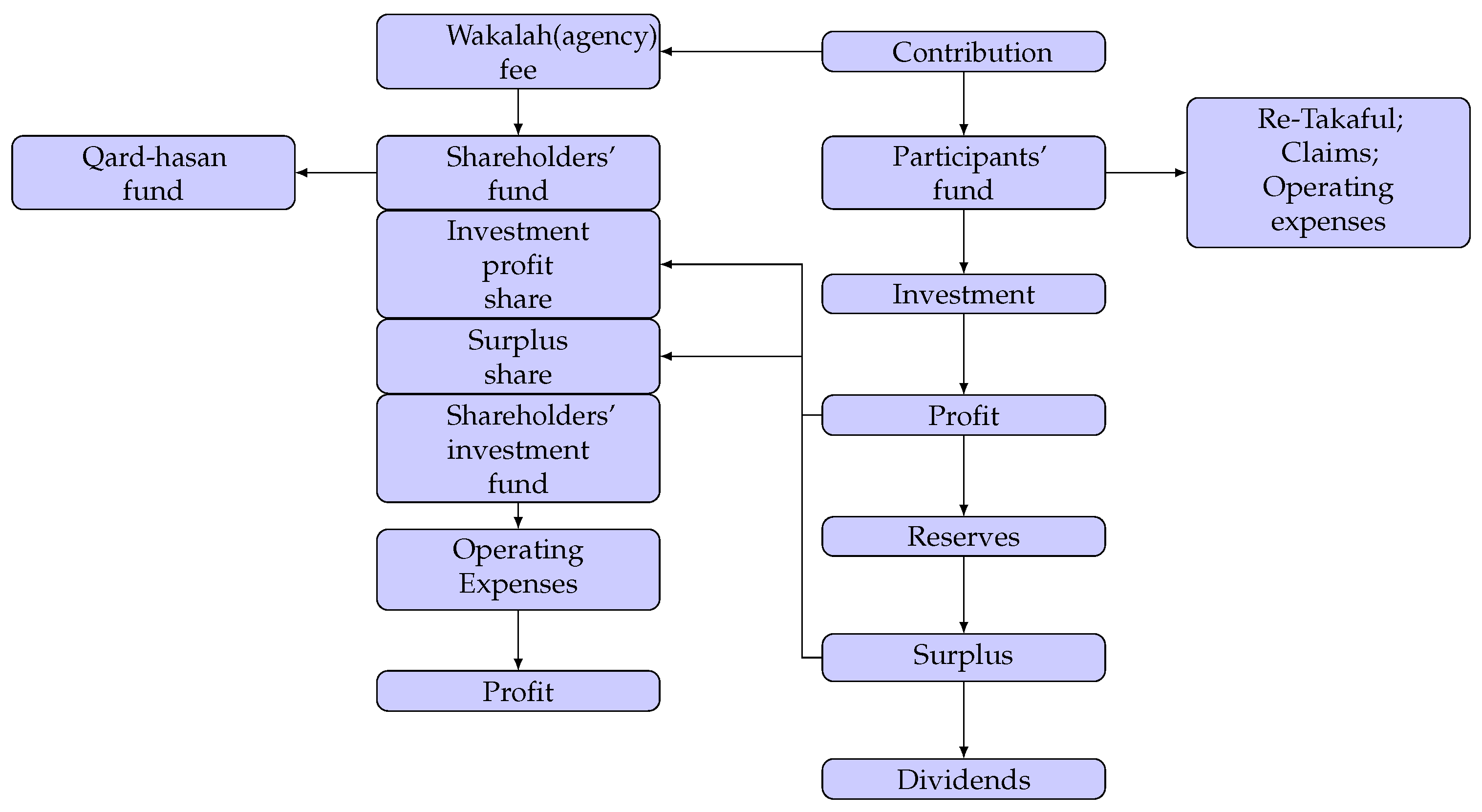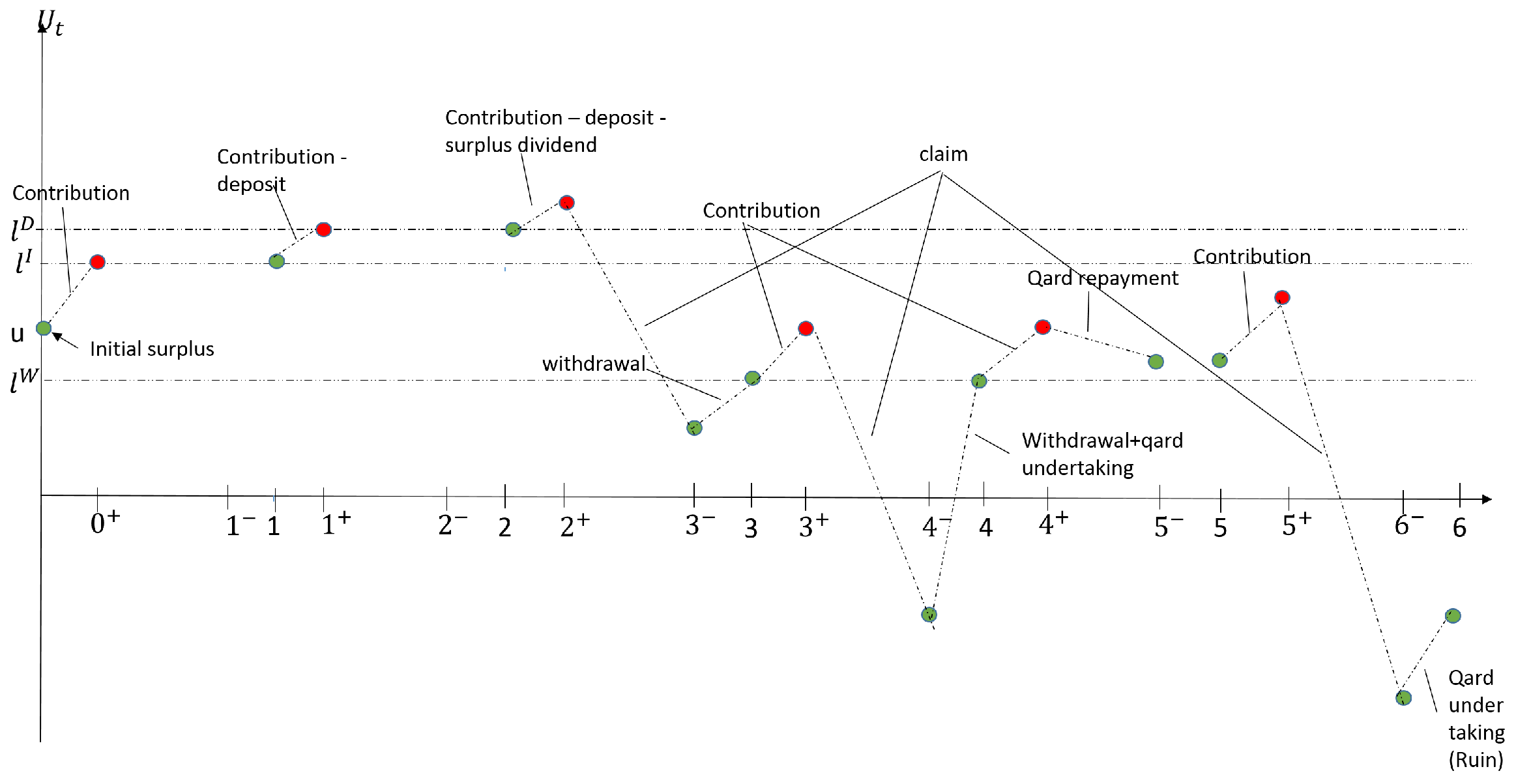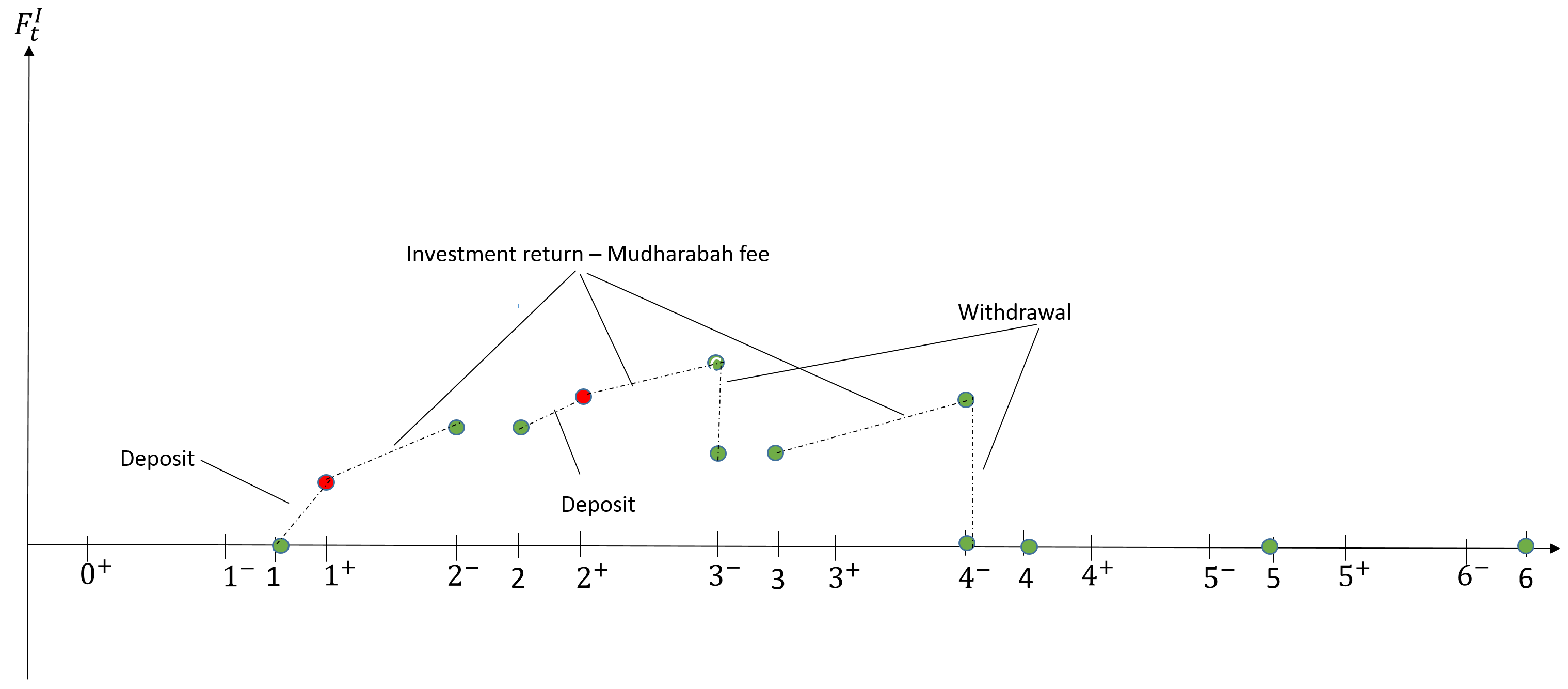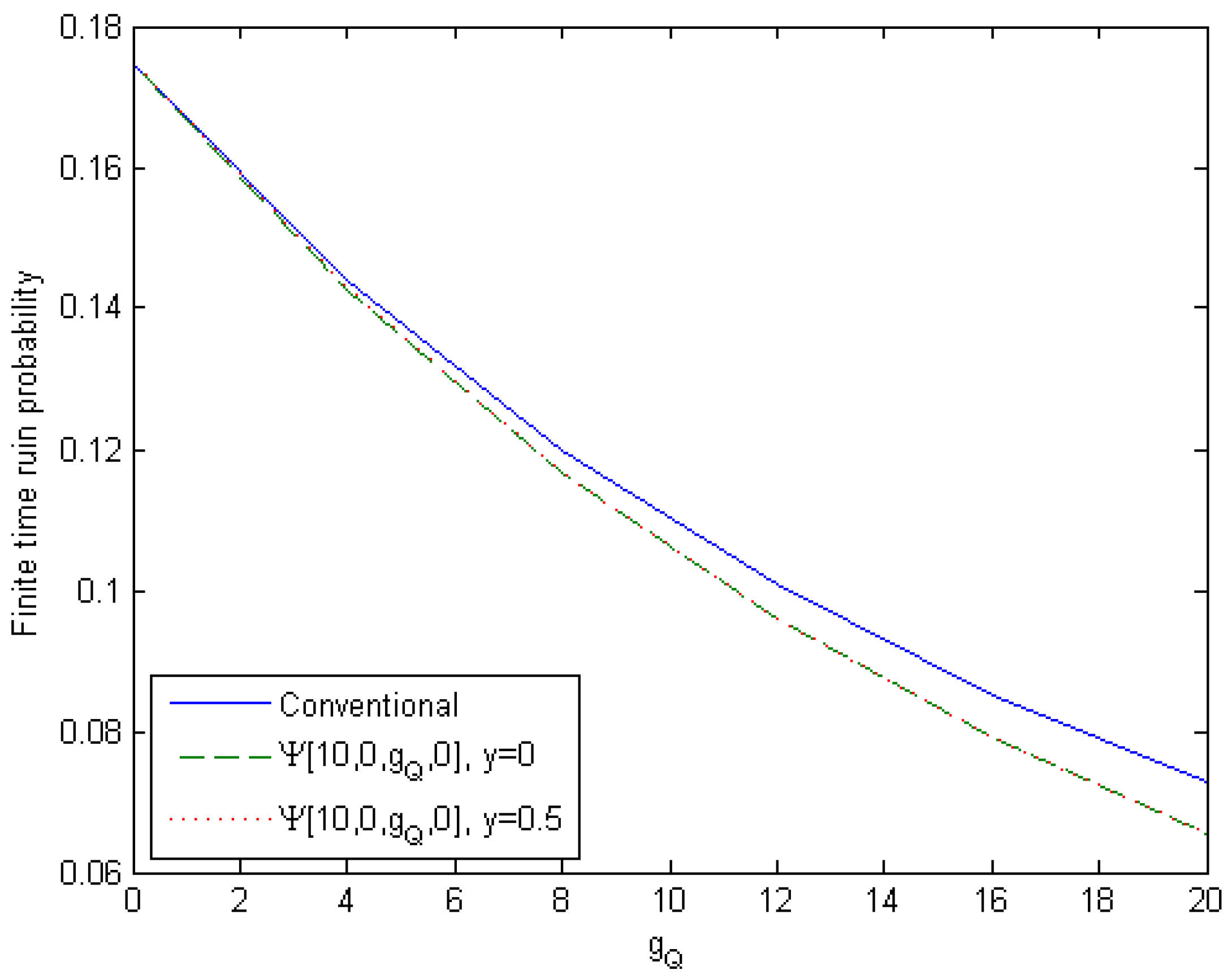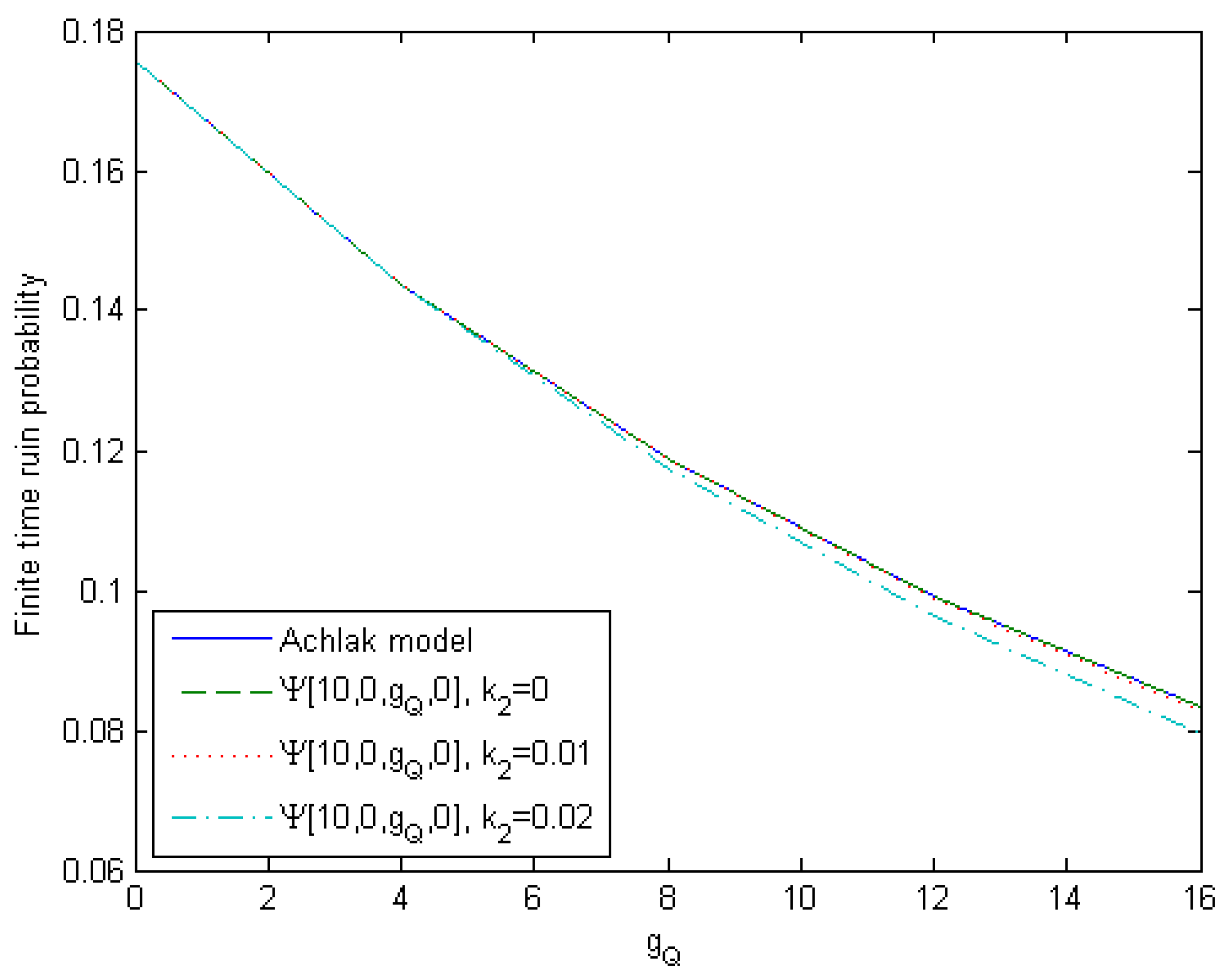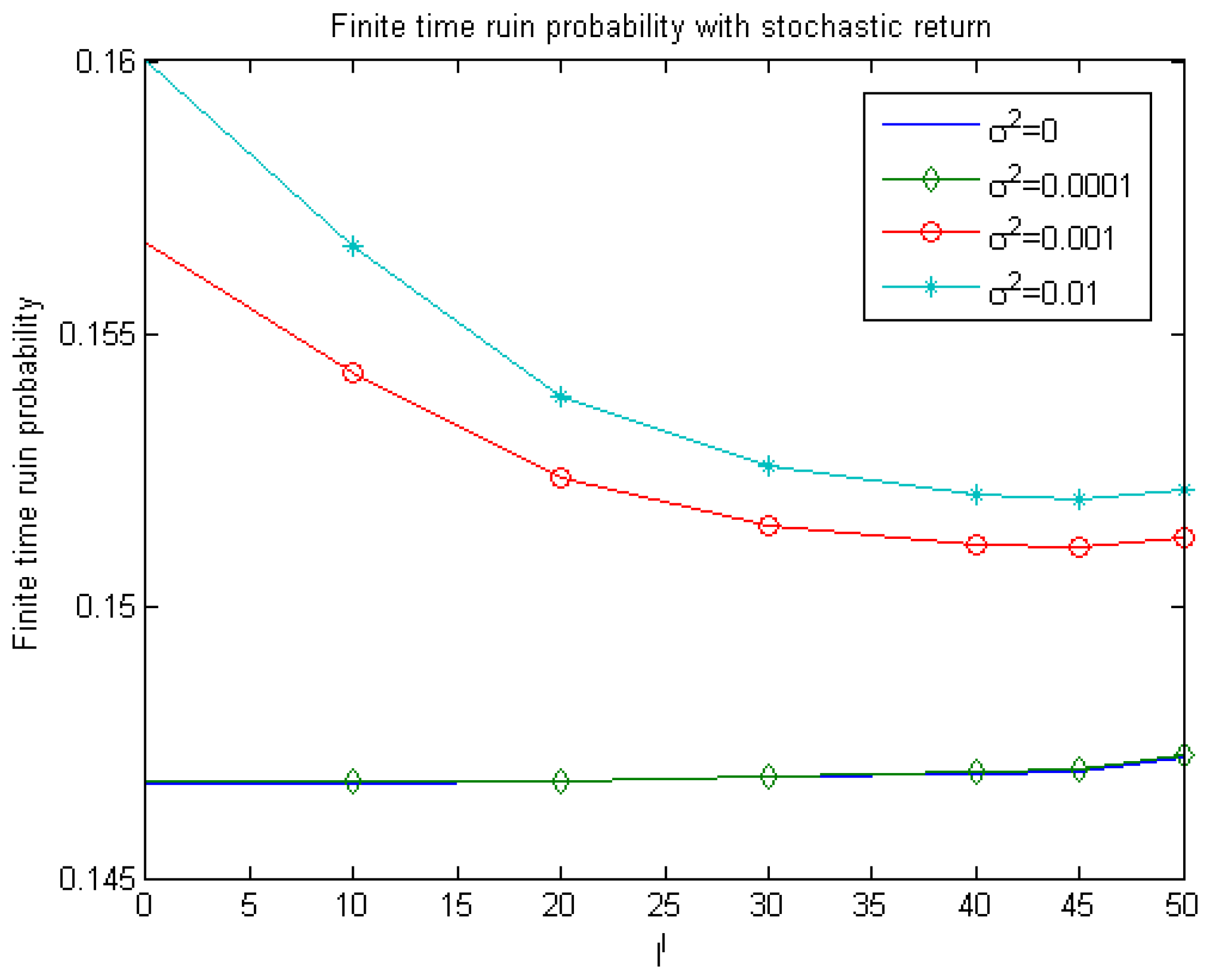1. Introduction
Socially Responsible Investment (SRI) has been gaining popularity from investors around the world. It incorporates non-financial concerns such as social, environmental, and moral issues as part of the investment decision, in addition to the financial return. Religion, besides union and green political parties, is one of the the most commonly studied in the SRI context (
Yan et al. 2019). Islamic finance is a class of SRI that complies with the principles of the Quran (Holy Book of Islam), the Hadith (teachings and sayings of Prophet Muhammad), and Ijtihad (scholarly legal deductions). Islamic finance is the only financial system in the world today that is based on the teaching of a dominant religion (
Hassan and Mahlknecht 2011). However, religion is not a prerequisite for the participation in Islamic finance. For example, in Malaysia, Takaful (Islamic insurance) products have attracted non-Muslim communities (
Swartz and Coetzer 2010).
Bhatti (
2019,
2020) review some legal aspects of Islamic finance and the practice of arbitration to resolve Islamic dispute to ensure the operations in the Islamic finance industry comply with Shariah rules. Based on the
GIFR (
2019) report, the Islamic finance industry had a positive annual growth of 6.58% during 2018, with a total asset value of 2.6 trillion USD at the end of 2018 in 75 countries from its three main sectors, namely: Islamic banking, Shariah capital market, and Takaful. This paper focuses on the study of Takaful, which is quite new compared to Islamic banking and capital market.
Insurance is an integral part of financial planning as efforts to keep away from potential adversities whenever such events occur. However, most Islamic scholars agree that conventional insurance is not acceptable under Shariah (Islamic law) due its interpretations with respect to Gharar (uncertainty), Maisir (gambling), and Riba (interest-bearing) (
Husain and Pasha 2011). Takaful is an alternative innovative instrument that provides similar protection as the conventional insurance except that it complies with Shariah law. The word Takaful is from Arabic that means to take care of one’s need (
Yusof et al. 2011). General (non-life) Takaful was first established in 1979 in Sudan, while family (life) Takaful was introduced later in 1984 by the Malaysian Takaful Act (
Kassim et al. 2013). According to the
IFDR (
2018) report, the Takaful industry is still growing at the rate of 19% in 2018, with total assets USD 46 billion from 324 Takaful operators in 47 countries. Moreover, it is anticipated that Takaful will continue to grow, especially in Muslim countries. For example, in Indonesia, with 98% Muslim population, the Indonesian Health Social Security Organising Agency (BPJS) and the Employment Social Insurance Administration Organisation (BPJS Employment) are currently developing Shariah-based products to attract Muslim citizens (
Bappenas 2018).
The growing trend of the Takaful market requires in-depth studies of its financial stability and actuarial modeling to make a better business decision.
Al Rahahleh et al. (
2019) review current developments of risk management in Islamic finance; however, the study focus on the Islamic banking sector only. Ruin theory is a fundamental study in actuarial science that analyses the dynamic evolution of the capital of insurance products driven by different sources of risk. One important problem in ruin theory is estimating the probability that surplus becomes negative at some point in the future. This is often described as the ruin probability problem. A brief overview of some current research on ruin probability can be found in (
Bulinskaya 2017). Because Takaful products have different features when compared with their conventional counterparts, it is conceivable that both lines of products will have very different risk characteristics. While the risk modelling of conventional insurance has been studied extensively, the corresponding study for the Takaful is extremely limited. For this reason, this paper contributes to the literature by developing a risk modelling framework for quantifying Takaful. In particular, we focus on the development of finite-time ruin probability for Takaful business, especially for a Hybrid model. In practice, this topic is helpful for enterprise risk management to study the probability of becoming insolvent before 10 or 20 years in a steady regime, which can be used to assess whether the activity is sustainable in a steady regime (
Gerber and Loisel 2012). The aim of this paper is to construct a Takaful risk model and to derive a finite-time ruin probability formula to quantify the risk associated with Hybrid-Takaful. We follow the idea of
Kim and Drekic (
2016) to construct a recursive formula to calculate ruin probability. We enhance the model by allowing an investment option with stochastic returns. We also incorporate qard-hasan facility (benevolent loan) in our risk model, which is an essential element to maintain Takaful solvency requirement (
Onagun 2011;
Rahim et al. 2017). This practice, for example, conforms with the Indonesia’s strategic plan in achieving the Sustainable Development Goals that the Indonesian government may provide a qard-hasan facility through Baznas (Indonesia’s national Zakat collection agency) to overcome the deficit of Shariah-based products (
Rehman 2019).
At the end of this paper, we present a numerical simulation study where we use the finite-time ruin probability to investigate the impact of some important variables on the performance of Takaful business. This study addresses a key concern on the optimal structure of the Takaful model that is mentioned in the
WTR (
2016) report. According to this report, many shareholders expect profitability in line with conventional insurers, while participants expect a unique product that fully embraces the principal ideas of Takaful. The results of our study demonstrate that by providing qard-hasan facility, Takaful product could outperform the conventional counterpart in view of its lower probability of ruin. Furthermore, if the operator invests the undrawn-down qard-hasan fund, then following the Shariah rule to pay off the qard-hasan undertaking may produce better performance.
The remainder of the paper is organized as follows.
Section 2 presents a literature review on the key subjects covered in this paper, namely the insurance ruin theory and the practice of Hybrid-Takaful. In
Section 3, we introduce the surplus model and the relevant mathematical variables. The construction of the finite-time ruin probability is explained in
Section 4.
Section 5 presents results of our numerical simulations.
Section 6 concludes the paper.
Appendix A contains the proof to the main results of the paper and
Appendix B summarizes the notation used in the paper.
3. Surplus Process for Hybrid-Takaful with Investment and Qard-Hassan Facility
In this section, we propose a surplus model for Hybrid-Takaful with investment activities and qard-hasan (non-interest loan) facility. The model is motivated by
Kim and Drekic (
2016), who consider a discrete-time dependent Sparre Andersen risk model in the context of conventional insurance. The first difference between our approach and the one by
Kim and Drekic (
2016) is in the loan fund feature. In our model, there is no interest in undertaking loans, as in the conventional model. The second difference is in the loan repayment arrangement. While the borrower in
Kim and Drekic (
2016) is forced to pay the loan undertaking (including interest) when it exceeds a certain level (i.e., loan capacity), in our model the borrower will repay the loan only if they generate a positive surplus in the future. The assumption of the loan arrangement in our model consistent with the IFSB’s rule. However, the lenders have a right to get a part of each shared underwriting dividend to compensate for their effort to provide a benevolent loan. The third difference relates to the assumption that the undrawn-down loan can be invested. The undrawn-down loan is the loan facility that is still available in the loan fund. In case of Takaful the loan fund is the qard-hasan fund. We should note that
Achlak (
2016) has also developed a Takaful risk model based on
Kim and Drekic (
2016) but with the assumption that the loan facility does not need to be repaid and can not be invested. In our study, we assume that the loan facility (i.e., qard-hasan facility) will be repaid from the future surplus, and the undrawn-down qard-hasan facility will be invested to enhance the facility. Finally, our model provides the option to invest in a risk-free or risky asset, and takes into account Mudharabah or fund management fee for operator from each generating investment return. In our Hybrid-Takaful risk model, we incorporate the following four separate financial accounts:
U: surplus fund
: investment fund
: qard-hasan fund
: liability account
and three thresholds levels:
: the minimal requirement of Takaful surplus level
: trigger level for investment activities
: trigger level for dividend payment
where the levels are assumed to satisfy .
As explained in
Section 2.2, there are two separate financial accounts in Takaful, namely participants’ funds and shareholders’ funds. The participants’ fund in our model is sub-divided into two separate financial accounts, namely, the surplus fund
U and the investment fund
. The reason for the separation of the two accounts is for better financial management, while the underwriting activities are represented in the surplus fund
U, the financial activities are in the investment fund
. The qard-hasan fund is a part of shareholders’ fund that is specially allocated as a benevolent loan for participants in case of deficit occurring due to underwriting activities. In our model, the drawn-down qard-hasan needs to be repaid from future surplus of the participants’ fund. We introduce the liability account
to keep track of the total of qard-hasan borrowed and refunded. In our model we assume that all funds are in discrete monetary accounts. We adopt this assumption to facilitate the recursive calculation of finite-time ruin probability in
Section 4.3.
By , and we denote the values of surplus level, the investment fund, the qard-hasan fund, and the liability account, respectively, at the end of the time interval (where ). We assume that a constant contribution (premium) of is received at , while claims are applied at . We also define , and as the participants’ surplus fund, investment fund, qard-hasan facility, and liability, respectively, immediately after a claim instance but before a withdrawal, borrowing, qard-hasan undertaking, and qard-hasan repayment instance.
A dividend trigger level
is a threshold that determines the dividend payment scenario. If
, a dividend amount of
from the underwriting surplus will be shared among participants and shareholders. In our model, we propose two options for the dividend distribution. In the first one, denoted by
, we assume a constant dividend, while in the second, denoted by
, we use a similar assumption to that adopted by
Achlak (
2016), namely, that the dividend is equal to
. We assume that the percentage of the dividends distributed to the participants and to the shareholders are given by
x and
, respectively, where
.
We define
as the contribution received at time
t and
as the total dividend distributed to shareholders at time
t. Thus,
where
and
A threshold
is a trigger point for investment activities. If
, a constant amount
is re-distributed to the investment fund at time
. We assume that investment activities during each time interval are carried out after all of the outstanding debts and claims are paid out. We denote the deposit amount corresponding to the time interval
as
, thus
Note that from Equations (
5) and (
6), if
, then both
and
are paid.
We also assume that the operator, as a fund manager, may invest in the Shariah (permissible) non-risky or risky assets, like sukuk (Islamic bond) or a Shariah stock. In Takaful, the operator acts as a fund manager as well. Hence, they have the right to receive “salary” from the participants’ fund due to this role. A Hybrid-Takaful model applies Mudarabah (profit-sharing) for an investment activity in which the operator receives a dividend payment from investment generated profit. We assume that the fund manager receives part of an investment gain.
Threshold
represents the minimum level of the acceptable surplus of the participants’ fund. If
drops, at some time between
and
t, below
due to claims, we withdraw from
, or borrow from
, to bring the surplus fund up to level
at time
t. A withdrawal from the investment account
is utilized first. We consider undertaking a interest-free loan from qard-hasan facility if the investment fund
is not sufficient to bring the surplus level back to
. The maximum qard-hasan that can be drawn down at time
t is the maximum value of
or the remaining money needed by
to reach
, whichever is smaller. The process will continue as long as the surplus-value is not negative. We assume that the un-drawn down qard-hasan fund will be invested in a risky or non-risky asset. The un-drawn down and investment gains will remain in the qard-hasan account to strengthen its facility. We denote the withdrawals and the qard-hasan undertaking amounts occurring during the time interval
by
and
, respectively. The above descriptions imply the following formulae:
Participants need to repay their total qard-hasan undertaking to the qard-hasan fund
in the future period when their surplus value is greater than
. We assume that the loan repayment will be paid instantly after the claim is paid out at
. If the surplus after claim payout at
is greater than
, then the loan will be repaid at
. The loan repayment amount should not make the surplus-value drop below
in any period. Unlike in the conventional counterpart, in the case when participants are not able to repay the qard-hasan, the undertaking qard-hasan will be counted as charity from shareholders to the participant. The participants are not obligated to repay the loan in case of a deficit. So, in our model, the loan repayment will not be the reason for ruin, but it will affect the value of
and
instead. We define
as the qard-hasan repayment corresponding to the time interval
. Thus, we have
Finally, the surplus level at time
t is the initial level of
u plus the total cash inflows from: contributions, withdrawal from investment fund, and loan undertaking from qard-hasan facility, minus the total cash outflows to: deposit investment, qard-hasan repayment, and claim payments. Thus,
We assume that the claim distribution of
and
has the same structure as in Sparre Andersen models
Cheung et al. (
2010). We also assume that the times between claims
and
i,
, are described by independent and identically distributed (iid) positive random variables
with probability mass function (pmf)
and the corresponding survival function
:
where
represents the upper bound for the interclaim times. Thus, for
, we have
We denote by
the conditional pmf of
given
:
and hence the joint pmf of
is of the form
We also assume that the pairs are iid.
In order to visualize the cash flow in our proposed Takaful risk model,
Figure 2,
Figure 3,
Figure 4 and
Figure 5 present illustrative examples of the evolution of the surplus fund, investment fund, qard-hasan facility fund, and the liability level respectively.
Appendix B summarizes the key symbols that are used in the paper. The surplus fund starts from an initial level
u, and the maximum capacity of the qard-hasan facility that is provided by shareholders at the initial point is
. The investment fund and the liability level are zero at the initial period. In each period, at time
there is contribution income deducted by deposit from investment fund and dividend payment if the corresponding trigger points are reached at time
t. If surplus drops below the level
due to claim payments at
, we withdraw from the investment fund and/or qard-hasan facility. Every qard-hasan undertaking and repayment activities is recorded in the liability fund.
5. Numerical Results
In this section, we implement the algorithm from
Section 4 to calculate the finite-time ruin probabilities based on the proposed Hybrid-Takaful model (i.e., Equation (
17)) through recursive Formula (
40). The objective is to study the effect some of the parameters may have on ruin probability and to investigate the performance of the proposed Takaful model in comparison with the conventional one. We use Wolfram-Mathematica version 9.0 to do all numerical calculations.
In our simulation study, we apply the set of input parameters as in
Kim and Drekic (
2016) and
Achlak (
2016), which will facilitate comparisons between the existing models and the proposed one. We assume that the interclaim time follows a truncated geometric distribution with
:
while the claim size distribution follows a discretized version of the Pareto distribution with mean 10.5 and variance 120
In all simulations, we set the contribution , the initial value for the participants’ fund , the initial value of the investment fund , and the initial value of liability . All these values are in the currency unit, for example, in million of dollars. We also assume that the rate of return for the investment fund () is 1% per month.
Figure 6 shows ruin probabilities for the time horizon
, and trigger points
, and
. We assume a constant dividend
, a deposit
, and an investment rate of return for qard-hasan fund
. We calculate ruin time probabilities for several values of the maximum loan capacity
. In our Takaful model, we need the percentage of Mudharabah fee (
y), while in the conventional model, this fee is zero. We consider two different values of
y, namely 0 and 50%.
For the surplus and investment fund, our proposed model has similar features as the conventional counterpart by
Kim and Drekic (
2016). Hence, under the assumption of no loan facility and no Mudharabah fee,
and
, the ruin probabilities of our proposed Takaful model are the same as in the the conventional one. The difference between our model and
Kim and Drekic (
2016) model is in the features of the loan activities. In the conventional model, there is an interest rate charged in each loan. In addition to that, the borrower is forced to repay the loan if the loan undertaking (including the interest rate) exceeds the maximum loan capacity. This rule may increase the chance of a ruin occurring. The qard-hasan facility in our proposed Takaful model has two benefits; the loan capacity may positively grow as a result of investing the undrawn-down qard-hasan, and the loan will be repaid if there is enough money in the surplus fund. We may see from
Figure 6 that the ruin probabilities of our proposed Takaful model with Mudharabah fee
or
are lower than the conventional counterpart. Moreover, a higher loan capacity produces a greater difference in ruin probabilities between the proposed Takaful model and the conventional one. The two different values of the Mudharabah fee that we have chosen in our implementation do not produce significantly different ruin probabilities.
Figure 7 compares the Takaful ruin time probabilities based on the proposed model with probabilities based on the model proposed by
Achlak (
2016). In the
Achlak (
2016) model, the qard-hasan fund is not invested, and there is no obligation for the participants to return the qard-hasan undertaking. We apply the same dividend value
as in
Achlak (
2016), with several values of the initial qard-hasan fund,
. Other input parameters are the same as the input parameters that we use in the previous simulation.
We also set 3 different values of the rate of return for qard-hasan fund (
). In the case of no qard-hasan facility, we obtain the same ruin probabilities as that based on the
Achlak (
2016) model for all values of
. This is because the surplus and investment features in our proposed model are the same as the ones in
Achlak (
2016). For
, when the qard-hasan fund is not invested (
), the qard-hasan repayment in our proposed model causes the ruin probability to be slightly higher than the one without loan repayment. This result can be explained by the fact that loan repayment causes a delay in depositing the investment fund. However, if we invest in the qard-hasan fund, the obligation of loan repayment leads to lower ruin probabilities than those without loan repayment. The difference between finite-time ruin probabilities with and without loan repayment becomes more visible when the initial value of the qard-hasan fund (
) increases.
Figure 8 represents finite-time ruin probabilities for the time horizon
with trigger points
,
,
, initial qard-hasan fund
, Mudharabah fee
, deposit
, and dividend
. We consider four different assumptions about the asset’s return: the first one is a non-risky asset with the rate of return of
per month. The other three are risky assets with the expected rate of return of
per month and variances 0.0001, 0.001, and 0.01. In this study we apply the
Cox et al. (
1979) model as explained in
Section 4.1.3. The graph suggests that the finite-time ruin probabilities increase as the variance of the asset is increased. In addition, we may see that the finite-time ruin probabilities for non-risky assets (
) and risky assets with low variance (
) increase as we increase the investment trigger level
. This phenomenon can be explained by the fact that when
increases then deposits in investment activities will be delayed. This, in turn, reduces the probability of ruin, since positive returns are earned from investment activities on the external fund only. However, the previous argument does not apply to the case of investing in the risky asset with high volatility, which can be explained by the fact that investing in such assets may produce large negative returns that will reduce the total reserve of Takaful fund. Thus, higher volatility of the asset price will increase the riskiness of the Takaful product, in the sense that higher volatility of the asset’s return produces a higher ruin probability. For both
and
, the optimal level to invest is
based on the ruin probability criterion.
